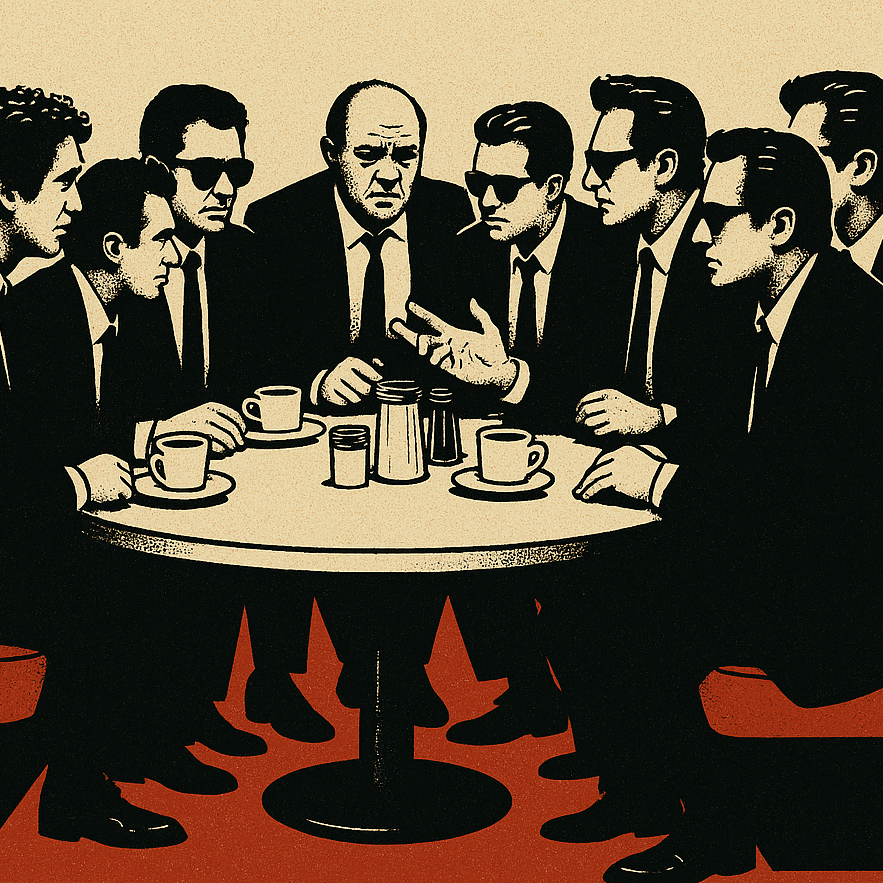Reservoir Dogs: How the Opening Scene Tells the Whole Story — and its Lessons for Screenwriters

Men in suits chatting about Madonna, tipping culture, and the meaning of a Madonna tune.
It seems talky, possibly aimless. Underneath, however, the scene tells us everything we need to know about each character. Let’s explore how the first ten minutes of Reservoir Dogs foreshadows the personalities, values, and fates of every major character in the film.
Tarantino’s razor-sharp dialogue and subtle blocking reveals who will live, who will die, who will betray, and who will bleed for loyalty.
I. Tarantino’s Table of Contents
The Reservoir Dogs opening introduces:
- Every main character
- The film’s tone: ironic, violent, and verbal
- The film’s major themes: loyalty, betrayal, identity, and masculinity
- Key character traits that unfold in tragic, bloody fashion
II. What Happens in the Scene?
Eight men sit around a diner table: Joe Cabot (the grizzled mob boss), his son Nice Guy Eddie, and six color-coded criminals—Mr. White, Mr. Orange, Mr. Blonde, Mr. Pink, Mr. Blue, and Mr. Brown.
They discuss:
- Madonna’s “Like a Virgin” (led by Mr. Brown)
- The ethics of tipping waitresses – or not (led by Mr. Pink)
- Joe demanding everyone contribute a dollar to the tip
On the surface, it’s a funny, rambling, indulgent slice of male banter.
Note, however, that each beat is meticulously designed to forecast the arcs and dynamics that will dominate the rest of the movie.
III. Mr. Brown: Crude, Confident, and Quickly Eliminated
Mr. Brown (played by Tarantino himself) opens the film with an overconfident interpretation of Madonna’s “Like a Virgin.” He asserts himself with a brash, hyper-sexual theory.
Of course he’s quickly mocked for it.
Note how much self-awareness this shows; this is precisely the sort of thing that Tarantino himself would be likely to say at a party, and he is actually aware that other people might well think he’s a total weirdo.
Foreshadowing:
Mr. Brown wants to make a splash, but he’s not taken seriously. His presence is short-lived, both at the table and in the story. He dies early during the botched getaway. Even in this one scene, we sense that he’s disposable—full of bluster but not integral to the operation.
Just as in horror, we are not put particularly put off when the loud asshole gets butchered early in the picture.
Lesson: The louder they are, the quicker they fall.
IV. Mr. Blue: The Mystery Man
Mr. Blue (Eddie Bunker) says virtually nothing, aside from mentioning his preference for old songs. He fades into the background immediately; note that he dies offscreen during the heist.
Foreshadowing:
Mr. Blue’s silence signals his narrative function: he’s a minor player, an expendable piece on the chessboard. Even his nostalgic comment about old music suggests a man out of time, possibly too old or disconnected to survive this new world of impulsive crooks.
Is he a placeholder? Just padding? Tarantino needed a reasonable number of people to make the heist work. A couple were bound to get iced early on. Why not cast one of your favorite writers–particularly one with a legitimate criminal past–in the part?
Lesson: The quieter they are, the quicker they go.
V. Mr. Pink: The Self-Justifying Survivor
Steve Buscemi’s Mr. Pink doesn’t believe in tipping. He backs this up with a rehearsed rationalization. He refuses to bow to group pressure, handing Joe back the dollar bill.
Foreshadowing:
This exchange captures Mr. Pink’s essence: individualistic and ruthlessly self-preserving.
He refuses to die for honor, friendship, or ideology. He figures out the situation and adapts. He is, notably, the only character who survives the film.
Key Line:
“I don’t tip because society says I have to. Alright, I mean I’ll tip if somebody really deserves it…”
Lesson: At least in a Darwinian sense, selfishness is an excellent preservation strategy.
VI. Mr. White: Loyal, Emotional, and Doomed by It
Harvey Keitel’s Mr. White defends the waitress, standing up to Mr. Pink. He values fairness, and later in the film, he shows loyalty toward Mr. Orange—despite hardly knowing him.
Foreshadowing:
Mr. White’s defense of the waitress highlights his emotional core and moral compass, even as a hardened criminal.
Tragically, this honorable emotional core is his undoing. Mr. White stakes his life on the belief that Mr. Orange isn’t a cop. When he finds out he’s wrong, the betrayal shatters him. He ends the film killing Joe and being shot by Eddie—then shoots Mr. Orange in the end (or so we are led to believe).
Key Line (not from diner, but reflected by it):
“I don’t want to kill you, but I will if I have to.”
Lesson: The man with a heart will see his heart broken.
VII. Mr. Blonde: Sociopathic Calm
Mr. Blonde (Michael Madsen) doesn’t speak much during the tipping conversation, but what he does say is telling. He subtly mocks the group and acts slightly detached. He seems amused by the debate but doesn’t meaningfully engage.
Foreshadowing:
This cool remove is what defines Mr. Blonde throughout the film. He’s the most dangerous character because he enjoys violence, doesn’t sweat loyalty, and–true to the profile of a legitimate psychopath–only pretends to follow rules when this behavior serves him.
Note how Blonde fakes compliance with Joe’s edicts. This gets Blonde inside the operation, but once inside, he massacres civilians during the robbery and tortures a cop while dancing to music.
Key Line (later):
“I don’t give a good fuck what you know, or don’t know, but I’m gonna torture you anyway.”
Lesson: The calmest guy at the table might be the sickest in the room.
VIII. Mr. Orange: Overcompensating and Hiding Something
Mr. Orange (Tim Roth) tries to blend in, telling a joke and laughing at others’ comments. He’s playing the part of a criminal, but something feels calculated.
He echoes others’ words. He watches. He doesn’t introduce any of his own ideas.
Foreshadowing:
We later learn Orange is an undercover cop.
In this scene, he’s already playing a role—adopting the culture, studying the dynamics, mimicking.
Witness “the commode story,” in which Mr. Orange rehearses a fake drug deal anecdote until it becomes “real.”
Key Visual Clue:
Mr. Orange glances around while others argue. He is calibrating. Testing the boundaries. A spy learning the language of criminals.
Lesson: To be successful, the confidence man must believe his own schtick.
IX. Joe and Nice Guy Eddie: Old Guard vs. Inherited Loyalty
Joe Cabot, the boss, enters late. He scolds the group for not tipping properly. He’s used to being obeyed. He makes the decisions, runs the job, and expects to be followed.
Nice Guy Eddie, his son, doesn’t say much in this scene, but he shadows his father’s actions and adopts his attitude.
Foreshadowing:
Joe and Eddie’s father-son bond becomes a crucial plot axis. When Joe threatens to kill Mr. Orange for being a rat, Mr. White protests. That escalates to a Mexican standoff where all three men kill each other.
The diner moment—Joe’s command to tip and the men’s acquiescence—is a subtle preview of how Joe’s word becomes law, even when this leads to chaos. Eddie, meanwhile, shows his blind loyalty to Joe, which later costs him his life.
Lesson: Old-school power cannot survive modern chaos.
X. Thematic Foreshadowing: Masculinity, Performance, and Inevitable Collapse
The diner scene in Reservoir Dogs sets up several core themes:
1. Masculine Performance
Posturing. Who’s smarter? Who’s tougher? Who’s got the best Madonna theory? These men bond through performance, not intimacy. That inability to connect authentically sets the stage for betrayal and mistrust later on.
2. Style of Talk as Identity
The film opens with words, not action. Tarantino uses speech to reveal identity. Each man’s fate can be traced back to how he speaks, what he believes, and how much of this is performance.
3. Loyalty vs. Survival
Mr. White tips because it’s “the right thing.” Mr. Pink refuses: “it’s a scam.”
The divide between idealism and pragmatism drives the final hour of the film. It ensures no one walks away clean.
XI. Final Shot: Walking in Slow Motion
As the men leave the diner, Tarantino gives us an iconic slow-motion shot of the group walking to “Little Green Bag.”
It’s cool, slick, and mythic—men in black suits, armed and ready. But once we’ve seen the film, that shot retroactively becomes tragic. Every one of those men is heading toward death, betrayal, or disillusionment.
The slow-mo shows the men strut, but each of them is heading toward death, betrayal, or disillusionment.
Everything You Need to Know Happens Before the Credits
Tarantino tells you the whole story in the first scene. Before the title appears, he’s already laid the emotional groundwork for all the major characters.
Every line in the diner creates character texture and narrative forecast. If you want to write a scene that introduces multiple characters without action—yet creates maximum narrative density—study this scene.
Nevertheless, it’s not just shitty, on-the-nose exposition.
Tarantino shows us who these characters are—in the way they eat, tip, argue, and laugh.
Postscript: Screenwriting Takeaways
- Layer in fate from the very first moment.
- Use idle conversation to plant seeds as to motivation and outcome.
- Make every line entertain now, yet haunt later.
